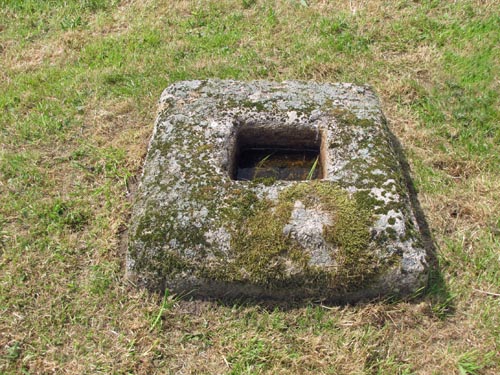 Location:
Beside the signpost at the road junction in Horndon. Location:
Beside the signpost at the road junction in Horndon.
O/S Grid Ref: SX/52041/80112
Longitude/Latitude (Degrees+/-): -4.09214/50.60191
Map location:
Click here
to view map.
Purpose: The socket stone would have
been used to support a cross in the area.
Size: The socket stone is 2 feet 4
inches (0.71 metres) square and 8 inches (0.20 metres) high. The
socket measures
9½ inches (0.24 metres) by 9 inches (0.23 metres) and is 5 inches
(0.13 metres) deep.
Information: This
well-crafted socket stone is square, with a chamfer running all around
the top edge. I'm afraid that I've not been able to discover
anything of the history of this stone. However, it is likely to
have supported a cross that was used to mark the route to a local
church, at either Mary Tavy or Peter Tavy, but I've no clue as to
where it was originally sited. It could, of course, have
supported a cross from its current position, but I think it more
likely that it has been brought here to preserve it from being
damaged.
 Opposite
the signpost and socket stone, the local post box has been built into
the stone wall. One of the stones, below and to the right of the
post box has a horizontal slot cut into it. In speaking to a
local resident, she confirmed that this stone was the top end of a
slotted gatepost, which has been reused in the wall. Slotted
gateposts were erected in pairs, and the slots in one post were quite
a bit deeper than those in the other. The 'gate' would simply
have been four or five separate planks of wood, each of which would be
slotted into one of the deeper holes and pulled across for the other end to
fit into the shallower slot - A simple form of early gate! Opposite
the signpost and socket stone, the local post box has been built into
the stone wall. One of the stones, below and to the right of the
post box has a horizontal slot cut into it. In speaking to a
local resident, she confirmed that this stone was the top end of a
slotted gatepost, which has been reused in the wall. Slotted
gateposts were erected in pairs, and the slots in one post were quite
a bit deeper than those in the other. The 'gate' would simply
have been four or five separate planks of wood, each of which would be
slotted into one of the deeper holes and pulled across for the other end to
fit into the shallower slot - A simple form of early gate!
 Just
down the road from the site of the cross base is the Elephant's Nest
Public House. Originally, the pub was called the 'New Inn', as
it was opened some time later than the 'Black Lion', which was sited further
along the lane. During the 1950's the landlord, Charles
Ossington, who was a very large rotund man, just about fitted on his
stool behind the very small and tight bar area. When customers
ordered drinks, he would simply swivel around on his stool and pour
the pint or use the optics. There just wasn't room for him to
get off his stool and move around to serve the drinks. One day,
one of his locals laughed and said that he looked just like an
'elephant sat on his nest' behind the bar. The landlord was so
taken by that description he decided that he would change the name of
the pub there and then! Just
down the road from the site of the cross base is the Elephant's Nest
Public House. Originally, the pub was called the 'New Inn', as
it was opened some time later than the 'Black Lion', which was sited further
along the lane. During the 1950's the landlord, Charles
Ossington, who was a very large rotund man, just about fitted on his
stool behind the very small and tight bar area. When customers
ordered drinks, he would simply swivel around on his stool and pour
the pint or use the optics. There just wasn't room for him to
get off his stool and move around to serve the drinks. One day,
one of his locals laughed and said that he looked just like an
'elephant sat on his nest' behind the bar. The landlord was so
taken by that description he decided that he would change the name of
the pub there and then!
|